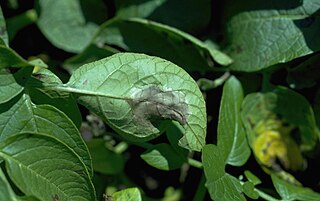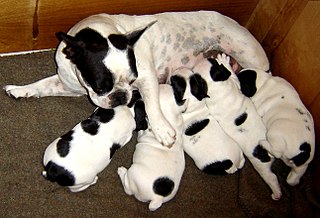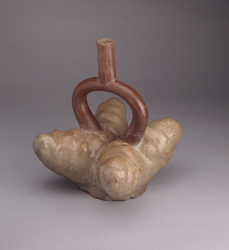
Genetic engineering, also called genetic modification or genetic manipulation, is the modification and manipulation of an organism's genes using technology. It is a set of technologies used to change the genetic makeup of cells, including the transfer of genes within and across species boundaries to produce improved or novel organisms. New DNA is obtained by either isolating and copying the genetic material of interest using recombinant DNA methods or by artificially synthesising the DNA. A construct is usually created and used to insert this DNA into the host organism. The first recombinant DNA molecule was made by Paul Berg in 1972 by combining DNA from the monkey virus SV40 with the lambda virus. As well as inserting genes, the process can be used to remove, or "knock out", genes. The new DNA can be inserted randomly, or targeted to a specific part of the genome.

The Great Famine, also known as the Great Hunger, the Famine or the Irish Potato Famine was a period of mass starvation and disease in Ireland from 1845 to 1849, which constituted a historical social crisis which had a major impact on Irish society and history as a whole. With the most severely affected areas in the west and south of Ireland, where the Irish language was dominant, the period was contemporaneously known in Irish as an Drochshaol, loosely translated as "the hard times". The worst year of the period was 1847, known as "Black '47". During the Great Hunger, roughly a million people died and more than a million fled the country, causing the country's population to fall by 20–25%, in some towns falling as much as 67% between 1841 and 1871. Between 1845 and 1855, no fewer than 2.1 million people left Ireland, primarily on packet ships but also steamboats and barque—one of the greatest exoduses from a single island in history.

The potato is a starchy tuber of the plant Solanum tuberosum and is a root vegetable native to the Americas. The plant is a perennial in the nightshade family Solanaceae.

Cannabis is a genus of flowering plants in the family Cannabaceae. The number of species within the genus is disputed. Three species may be recognized: Cannabis sativa, Cannabis indica, and Cannabis ruderalis; C. ruderalis may be included within C. sativa; all three may be treated as subspecies of a single species, C. sativa; or C. sativa may be accepted as a single undivided species. The genus is widely accepted as being indigenous to and originating from Asia.

In agriculture, monoculture is the practice of growing one crop species in a field at a time. Monoculture is widely used in intensive farming and in organic farming: both a 1,000-acre cornfield and a 10-hectare field of organic kale are monocultures. Monoculture crops have allowed farmers to increase efficiency in planting, managing, and harvesting, mainly by facilitating the use of machinery in these operations, but monocultures can also increase the risk of diseases or pest outbreaks. Diversity can be added both in time, as with a crop rotation or sequence, or in space, with a polyculture or intercropping.

Phytophthora infestans is an oomycete or water mold, a fungus-like microorganism that causes the serious potato and tomato disease known as late blight or potato blight. Early blight, caused by Alternaria solani, is also often called "potato blight". Late blight was a major culprit in the 1840s European, the 1845–1852 Irish, and the 1846 Highland potato famines. The organism can also infect some other members of the Solanaceae. The pathogen is favored by moist, cool environments: sporulation is optimal at 12–18 °C (54–64 °F) in water-saturated or nearly saturated environments, and zoospore production is favored at temperatures below 15 °C (59 °F). Lesion growth rates are typically optimal at a slightly warmer temperature range of 20 to 24 °C.

Genetically modified foods, also known as genetically engineered foods, or bioengineered foods are foods produced from organisms that have had changes introduced into their DNA using the methods of genetic engineering. Genetic engineering techniques allow for the introduction of new traits as well as greater control over traits when compared to previous methods, such as selective breeding and mutation breeding.

Genetic diversity is the total number of genetic characteristics in the genetic makeup of a species, it ranges widely from the number of species to differences within species and can be attributed to the span of survival for a species. It is distinguished from genetic variability, which describes the tendency of genetic characteristics to vary.

Dog breeding is the practice of mating selected dogs with the intention of maintaining or producing specific qualities and characteristics. When dogs reproduce without such human intervention, their offspring's characteristics are determined by natural selection, while "dog breeding" refers specifically to the artificial selection of dogs, in which dogs are intentionally bred by their owners. Breeding relies on the science of genetics, hence a breeder who is knowledgeable on canine genetics, health, and the intended purpose of the dogs attempts to breed suitable dogs.
Purebreds are "cultivated varieties" of an animal species achieved through the process of selective breeding. When the lineage of a purebred animal is recorded, that animal is said to be "pedigreed". Purebreds breed true-to-type which means the progeny of like-to-like purebred parents will carry the same phenotype, or observable characteristics of the parents. A group of purebreds is called a pure-breeding line or strain.

A landrace is a domesticated, locally adapted, traditional variety of a species of animal or plant that has developed over time, through adaptation to its natural and cultural environment of agriculture and pastoralism, and due to isolation from other populations of the species. Landraces are generally distinguished from cultivars, and from breeds in the standardized sense, although the term landrace breed is sometimes used as distinguished from the term standardized breed when referring to cattle.

Michael Kevin Pollan is an American author and journalist, who is currently the Knight Professor of Science and Environmental Journalism at the UC Berkeley Graduate School of Journalism.

This article presents common techniques and facts regarding the cultivation of cannabis, primarily for the production and consumption of its infructescences. Cultivation techniques for other purposes differ.

Genetically modified crops are plants used in agriculture, the DNA of which has been modified using genetic engineering methods. Plant genomes can be engineered by physical methods or by use of Agrobacterium for the delivery of sequences hosted in T-DNA binary vectors. In most cases, the aim is to introduce a new trait to the plant which does not occur naturally in the species. Examples in food crops include resistance to certain pests, diseases, environmental conditions, reduction of spoilage, resistance to chemical treatments, or improving the nutrient profile of the crop. Examples in non-food crops include production of pharmaceutical agents, biofuels, and other industrially useful goods, as well as for bioremediation.
Postnaturalism is the theory of the postnatural, a term coined to describe organisms that have been intentionally and heritably altered by humans. Postnaturalism is a cultural process whereby organisms are bred to satisfy a specific cultural purpose. It can be used to read these organisms, which serve as insights into our culture by reflecting desires and beliefs prevalent at the time of breeding. This has direct implications for the evolutionary path of these organisms, whittling down undesirable traits to leave only those culturally sought out. Postnaturalism argues that in so doing, humans have and continue to actively alter the evolutionary path of a postnatural organism to suit our cultural desires. The agricultural practice of monoculture, for instance, is just one example of postnatural organisms who have been bred to such an extent that the modern-day species look nothing like their pre-neolithic counterparts. The breeding of these species for this purpose can be seen to be reflected in notable diet changes during this period, which proliferated during ensuing sedentism and urbanisation.

In Defense of Food: An Eater's Manifesto is a 2008 book by journalist and activist Michael Pollan. It was number one on the New York Times Non-Fiction Best Seller List for six weeks. The book grew out of Pollan's 2007 essay Unhappy Meals published in the New York Times Magazine. Pollan has also said that he wrote In Defense of Food as a response to people asking him what they should eat after having read his previous book, The Omnivore's Dilemma.

The Propitious Esculent: The Potato in World History is a book by John Reader outlining the role of the potato in world history. It was also published under the titles The Untold History of the Potato and Potato: A History of the Propitious Esculent.

The potato was the first domesticated vegetable in the region of modern-day southern Peru and extreme northwestern Bolivia between 8000 and 5000 BCE. Cultivation of potatoes in South America may go back 10,000 years, but tubers do not preserve well in the archaeological record, making identification difficult. The earliest archaeologically verified potato tuber remains have been found at the coastal site of Ancón, dating to 2500 BC. Aside from actual remains, the potato is also found in the Peruvian archaeological record as a design influence of ceramic pottery, often in the shape of vessels. The potato has since spread around the world and has become a staple crop in most countries.
Redcliffe Nathan Salaman was a British physician, pathologist, botanist and potato breeder. His landmark work was the 1949 book The History and Social Influence of the Potato, which established the history of nutrients as a new literary genre.














